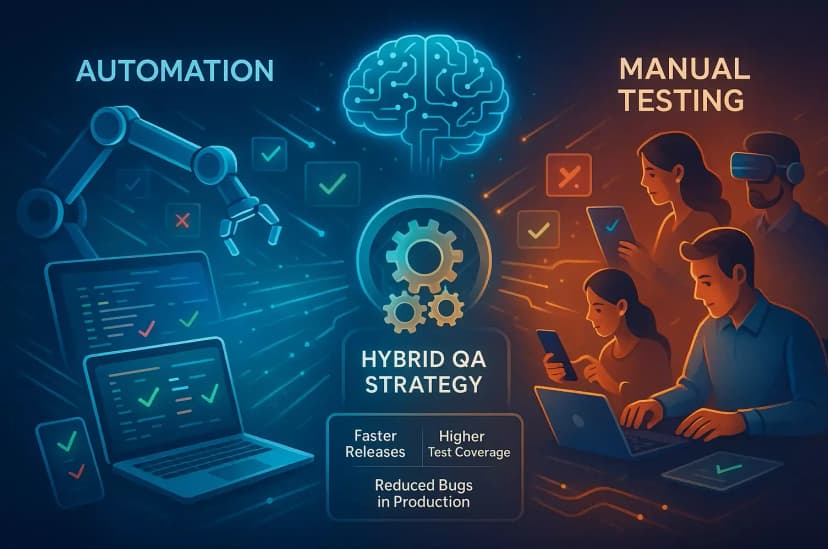In the fast-moving world of software development, quality assurance must be as agile as the code it supports. Automation testing brings speed, scalability, and consistency, while manual testing delivers human insight, visual precision, and the ability to explore unexpected behaviour.
Instead of treating them as competing approaches, successful QA teams use a hybrid model — one that blends automation for stability and speed with manual testing for intuition and flexibility. This article explores when to use each, how to combine them effectively, and how a hybrid strategy enhances overall test coverage and releases confidence.
Manual vs Automation Testing: Core Differences
| Criteria | Manual Testing | Automation Testing |
|---|---|---|
| Execution Speed | Slower | Faster, ideal for regression |
| Human Intuition | Strong — great for UX and visual checks | Limited to scripted logic |
| Reusability | Low | High — reusable across builds and devices |
| Initial Investment | Minimal | High — setup, scripting, tooling required |
| Flexibility | High — great for UI changes | Requires updates for each UI change |
| Best Use Cases | Exploratory, ad hoc, usability testing | Regression, API, data-driven, and cross-browser |
When to Use Manual Testing
Manual testing shines in scenarios where human observation, empathy, or creative exploration is key. It’s especially effective for testing:
- New or frequently changing UI components
- Visual layouts, design consistency, and responsiveness
- Usability, accessibility, and customer experience flows
- Exploratory and ad hoc testing
- One-time or short-lived feature validations
It enables testers to assess user behaviour, identify visual inconsistencies, and uncover unexpected edge cases that automation may overlook.
When to Use Automation Testing
Automation testing is ideal for stable, repeatable, and high-volume testing scenarios such as:
– Regression tests executed across releases
- API validations and backend logic
– Performance, load, and stress testing - Data-driven test scenarios
- Multi-browser and multi-device test coverage
Automation enables teams to run thousands of test cases at scale, reduces human error, and integrates with CI/CD pipelines for continuous feedback.
The Hybrid Testing Model Explained
Rather than choosing between manual and automation, a hybrid model combines both — creating a strategic QA workflow that balances speed and intelligence. It allows teams to:
- Automate critical, repetitive flows
- Manually test UI/UX-intensive or high-risk changes
- Execute parallel testing for faster coverage
- Use exploratory testing to supplement automated scenarios
In Agile and DevOps environments, this hybrid model supports frequent deployments while maintaining high product quality.
Sample Hybrid Strategy for a Web Application
| Feature Area | Testing Type | Approach |
|---|---|---|
| Login & Authentication | Regression | Automate using Selenium |
| UI Layout | Visual Comparison | Manual with cross-browser checks |
| Product Search | Functional & Load | Cypress + JMeter |
| Checkout Flow | End-to-End | Mixed (manual + automated) |
| Accessibility | Compliance | Manual with WCAG guidelines |
| API Integration | Backend | Automate with Postman + Newman |
Benefits of a Hybrid QA Approach
Combining manual and automation testing offers several strategic advantages:
- Balanced coverage: Automation handles scale, manual handles nuance
- Optimized QA resources: QA engineers can focus on higher-value tasks
- Agile-aligned testing: Supports fast cycles with thoughtful validation
- Reduced release risk: Regression bugs caught early; usability issues spotted pre-release
- Faster feedback: Immediate alerts through automated CI pipelines, enriched by manual exploration
Frequently Asked Questions
Q: Can all test cases be automated?
A: No. Tests involving design, usability, or exploratory workflows require human observation and judgment.
Q: How should teams decide what to automate?
A: Automate stable, repeatable, and business-critical scenarios. Keep UI/UX, design validations, and one-off flows manual.
Q: Is hybrid testing compatible with Agile?
A: Absolutely. It allows you to automate regression while manually testing new sprint features — aligning perfectly with Agile workflows.
Conclusion
A modern QA strategy is neither all-automated nor all-manual — it’s hybrid. By combining the precision of automation with the insight of manual testing, teams can reduce bugs, improve release quality, and stay agile in ever-changing product environments.
At Testriq QA Lab LLP, we build hybrid frameworks that deliver real-world results. Whether you’re launching a new product or scaling your QA team, we’ll help you strike the right balance between speed and coverage.
About Nandini Yadav
Expert in Automation Testing Services with years of experience in software testing and quality assurance.
Found this article helpful?
Share it with your team!
